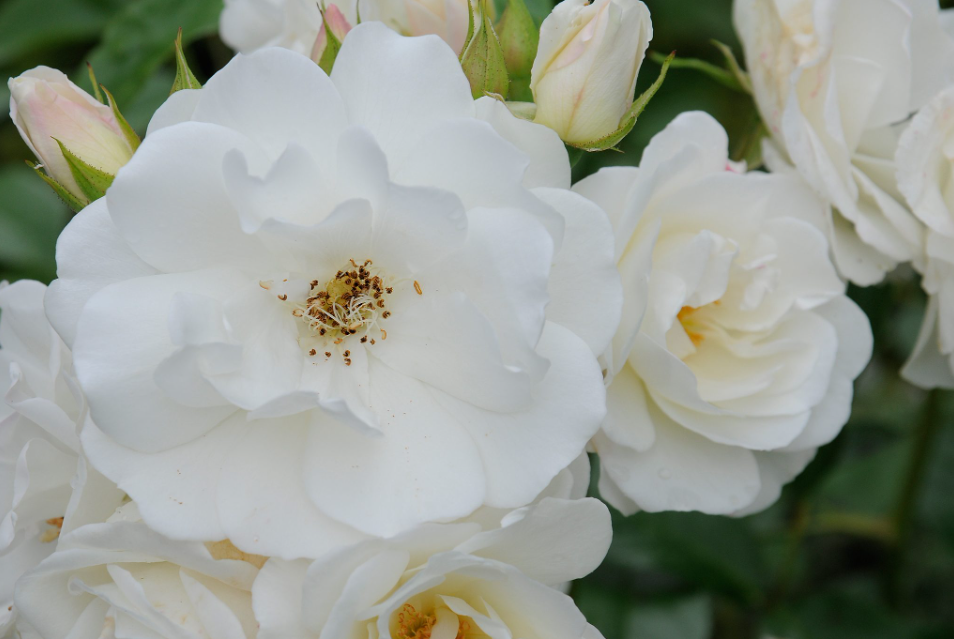
The Iceberg Rose, also known as Rosa ‘Iceberg’, is a floribunda rose with abundant clusters of medium-sized, double flowers with soft white petals and a subtle touch of pale pink. It is highly acclaimed for its hardiness, disease resistance and vigorous growth. It is usually considered one of the finest roses ever developed, with large, double, 3-inch blooms with up to 24 petals.
The Iceberg Rose, also known as Rosa ‘Iceberg’, was developed in 1958 by Reimer Kordes of W. Kordes & Sons in Germany in Germany in 1958. The parent varieties of ‘KORbin’ are ‘Robin Hood’, a red hybrid musk rose developed by Joseph Pemberton in 1927 in England, and ‘Virgo’, a white hybrid-tea rose bred in France by Charles Mallerin in 1927. The cultivar was registered under the name ‘KORbin’ by Kordes in 1958 and given the trade name Schneewittchen. It is known as Fée des Neiges in French and Iceberg in English.
The Iceberg rose debuted in 1958. It quickly rose to fame, winning a Royal National Rose Society Gold Medal that same year. This acclaim continued in 1983 when the World Federation of Rose Societies declared it the “World Favourite Rose” and inducted it into their hall of honor. Interestingly, the rose also held the esteemed German ADR title from 1960, though it was revoked in 2004 for undisclosed reasons.
Characteristics of Iceberg Rose
- Size and Growth Habit: It is a deciduous shrub that grows to 3-4 feet tall. It has a mounding growth habit and can also be grown as a climber, reaching up to 12 feet tall.
- Growth Rate: It is a fast-growing rose. It can grow up to 2 feet per year.
- Flower: It produces clusters of medium-sized, semi-double flowers that are pure white with a slight hint of pink at the base of the petals.
- Bloom Time: It is a repeat bloomer, it produces flowers throughout the growing season, from late spring to frost.
- Fragrance: The flowers have a mild, sweet fragrance.
- USDA Zone: It is hardy in USDA zones 5-9. It can withstand winter temperatures down to -20 degrees Fahrenheit.
- Lifespan: This is a relatively long-lived rose. With proper care, it can live for 20 years or more.
- Hardiness: It is resistant to many common rose diseases, including mildew and rust. However, it is somewhat susceptible to black spot.
- Continuous Blooms: It flowers repeatedly throughout the growing season.
Cultivation
- Choose a sunny spot with well-drained soil. Iceberg Roses thrive in full sun, requiring at least 6 hours of direct sunlight per day.
- Ensure the soil is well-drained and rich in organic matter. Amend heavy clay soils with compost or other organic materials to improve drainage.
- Plant Iceberg Roses in early spring or fall. Dig a hole twice as wide and just as deep as the root ball. Place the rose in the hole, backfill with soil, and water thoroughly.
- Water Iceberg Roses deeply once a week, especially during dry spells. Avoid overhead watering to prevent fungal diseases.
- Apply a balanced, slow-release fertilizer in early spring and again in early summer.
- Prune Iceberg Roses in late winter or early spring before new growth begins. Remove dead, diseased, or crossing branches. Cut back the remaining canes by about one-third to promote vigorous growth.
- In cold climates, protect Iceberg Roses by mounding soil around the base of the plant and covering it with a layer of mulch.
- Remove spent flowers to encourage more blooms and maintain a tidy appearance.